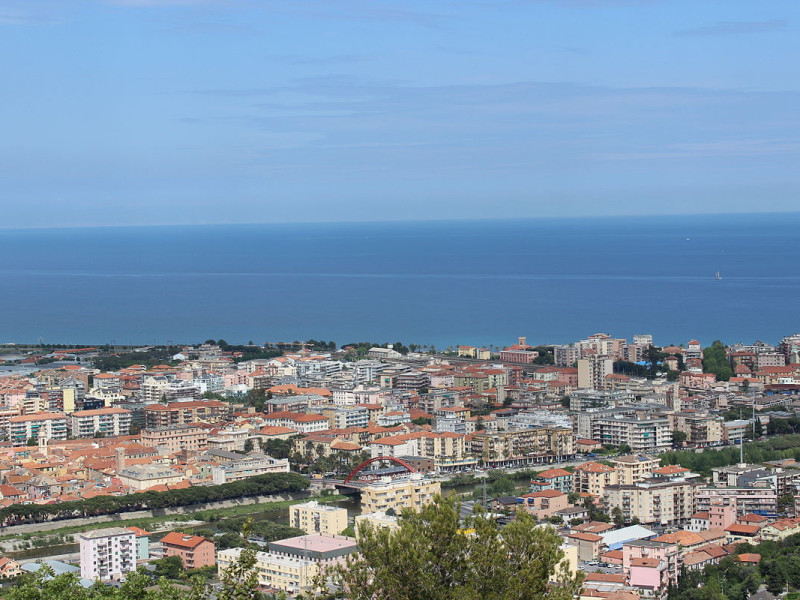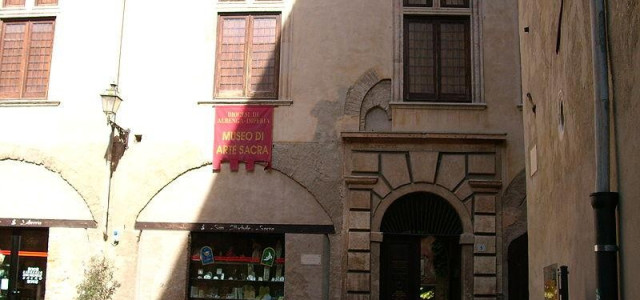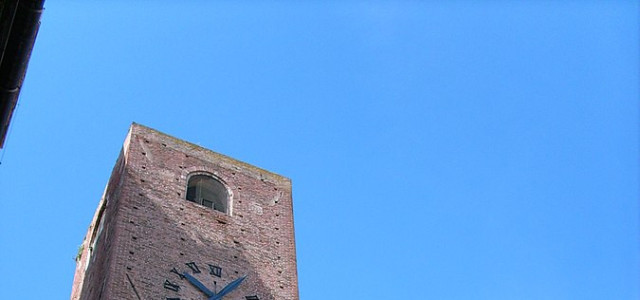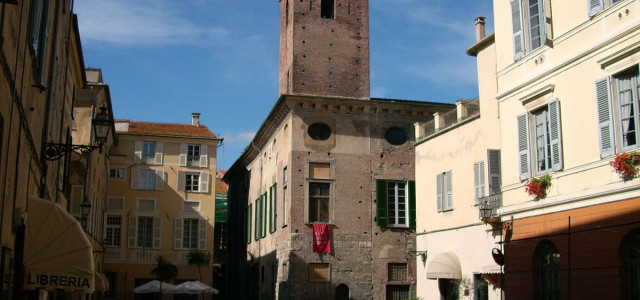Albenga
Albenga is a city and comune situated on the Gulf of Genoa on the Italian Riviera in the Province of Savona in Liguria, northern Italy. Albenga has the nickname of city of a hundred spires. The economy is mostly based on tourism, local commerce and agriculture. Albenga has six hamlets: San Fedele, Lusignano, Campochiesa, Leca, Bastia, Salea. History A settlement of pre-Roman origins on the west side of the Ligurian coast, it was founded around the 4th century BC on the slopes of the coastal hills, becoming the capital of the Ingauni Ligures tribe, who dedicated to marine activities and controlled a large territory between Finale and Sanremo. During the Second Punic War the city allied itself with the Carthaginians, but were defeated by the Romans under proconsul Lucius Aemilius Paullus Macedonicus in 181 BC. The following year the Romans and the Ingauni signed a foedus (alliance agreement) which began the total Romanization of the whole region. Put under Latin rights in 89 BC, Albingaunum was granted the Roman citizenship in 45 BC under Julius Caesar, starting to enjoy, with the beginning of the Empire, a period of prosperity. A further boost for the city came from the building of the Via Julia Augusta (13 BC), connecting it to southern France and Spain. In the meantime the intense exploitation of the flat land around the city continued. During the 5th century, the city suffered the raids of the Visigoths, who partly destroyed and sacked it. The old Municipium, turned in disastrous conditions, was rebuilt for the intervention of emperor Constantius III who gave the city stability and a difensive structure that allowed it to survive and to go through the events of the following centuries. Albenga established itself as a commune in 1098; in that same year it took part to the First Crusade with vessels, men and money, receiving rights of free trade by the King of Jerusalem. From that moment on, the Golden Red Cross coat of arms waved on its ship and on its towers. Later on, after the invasion of northern Italy by emperor Frederick Barbarossa, the city supported him thanks to its Ghibelline allegiance, which was never abandoned during the following centuries. In 1159 it received the imperial investiture for all its territory. In 1798 Albenga was declared capital of the Centa Jurisdiction, as part of the short living constitution of the Ligurian Republic. In 1815 the city, together with the whole Liguria, was assigned to the Savoyard Kingdom of Sardinia, becoming the capital of a province including Andora and Finale Ligure. In 1863, after the unification of Italy, the province was reduced to a district, and was abolished completely in 1927. At the time Albenga had reduced into an agricultural village, overtaken by other coastal towns for what concerned both economic and demographic development, due to their superior touristic appeal. The name The name of Albenga comes from the Latin Albíngaunum that comes from Album Ingaunum, that is means the capital city + genitive plural in -um. The ethnonym Ingauni ing consists of Indo-European origin, and a name of Gaul-ligurian land. Album comes from alb o alp an ancient pre-Indo-European (rock, hill), often erroneously assocciata to "album" a Latin word meaning white or clear. The first name was Album Ingaunum, but when it was conquered by the Romans, the name became Albingaunum; after the Roman Empire the name became Albinauno and near the 1000 became Albingano. Only in the 14th century the name became Albenga. Geography Albenga is located in the west Riviera. It has a homonymous plain at the mouth of the river Centa, which over the centuries has been the architect of the Albenga's plain, remodeling the ground several times and forcing the Albenganesi to adopt embankments and bridges since its foundation. Until the 17th century, it based its economy on maritime trade, as the city was built on the delta of the Centa and was surrounded by walls and bridges. With the closure of other roads estuary delta, which occurred first at the hands of the Genoese and later as the work of nature, now the river runs along the center flowing to the estuary. Even the memory of the old bridges was deleting itself. It is the main center of the district Albenganese, which extends from Finale to Andora and its hinterland. It includes the nature reserve of island Gallinara, where apparently lived St. Martin of Tours. Just dedicated to this saint was a monastery on the island. After 1064 it became the possession of the abbey of Abbadia Alpina. Climate The climate is mild along the coast, with mild winters and hot summers and cold but rarely mitigated by the sea breeze. In the inner part of the plain, are felt more continental characteristics, which create a greater temperature range, temperature minimum harsher winter and summer maximum higher. Main sights Built on the ancient orthogonal structure that had the current "Via Medaglie d'oro" and "Via Enrico d'Aste" respectively as the Roman camp main road axes (cardo and decumanus), the town has its planimetric hub in the historical San Michele Square. Around it some palaces were built, which were historically the seats of political and religious authorities. Cathedral of St. Michael Archangel Built on the basic structures of the early Christian basilica put up by orders of Constantius III between the 4th and 5th century, it has a façade with traces of the transformation from Romanesque to Gothic. From this same period are the two lateral portals of the main facade and a third one the left side of the church, that hosts a restored Lombard bas-relief; the central portal dates from 1669. The current design is the result of further elevations. The restoration works between 1964 and 1967 brought back the cathedral design to its original medieval aspect. The nearby steeple was attached to the church in the 13th century, built over the ruins of the old bell tower between the years 1391 and 1395. This construction is one of the last local examples of the use of bare bricks, progressively replaced by plastering. Baptistery The baptistery is located to the side of the Cathedral, as it was typical of the early Christian structures, and can be visited from the Loggia of the old City Hall Palace. It has an octagonal interior dating to the 5th century. The current appearance dates from a late 19th-century restoration work, carried on by Alfredo D'Andrade. During those works, the original basin vaulted roof, built with the Byzantine-Ravennate technique of the "tubi fittili" (terracotta tubes), was completely destroyed. The mosaic decorations of the vault of the presbytery go back to the 5th and 6th centuries. Old city Hall Palace Dating back to the early 14th century, it has undergone several renovations over the years before receiving its present appearance. It housed the Council Hall (the big bell still calls the citizens when the council committee meets in the new town hall) and the jail. The lower floor dates from the 14th century, while the upper one was reconstructed in 1387–1391. The façade towards the baptistery has Ghibelline-style merlons with two large staircases. Since 1933, it houses the Ingauni Museum. The latter, established in 1933 by Nino Lamboglia, collects objects and medieval Roman (sculptures, inscriptions, sarcophagi and 15th-century frescoes), archaeological and epigraphic collections. Old Bishop's Palace Located near the baptistery, it dates from the 11th century, with a 13th-century portal. It is the seat of the local bishop and houses the Holy Art Museum. The wing leading to the baptistery show several construction phases from the 13th and 14th centuries. The decoration with black and white stripes was added in 1463 under bishop Napoleone Fieschi. The heraldic fresco is by Giovanni Canavesio (1477). The Diocesan Museum of Albenga occupies a series of rooms decorated with frescoes, it houses works of art and findings from the excavation of the cathedral. Among the paintings stand out a St. John attributed to Caravaggio and The Martyrdom of Saint Catherine by Guido Reni. Ancient remains Restructured by Emperor Augustus in 13 BC, the Via Julia Augusta was the most important communication link in the Riviera up until the construction of the Napoleonic road closer to the sea, the current site of the Via Aurelia. Its path, with plenty of Roman buildings destined to funerary celebrations, makes an archaeological walk beautiful also from a panoramic an naturalistic point of view. Albenga is also home to the remains of a Roman amphitheatre dating from the 3rd century BC. It represents the only example of theatrical construction known on the entire Western Riviera. Placed a short distance away from the Amphitheatre and from the Via Julia Augusta, is the so-called Pilone, standing over the eastern slope of the Mount. This is the most renowned and characteristic Ingaunian funeral monument. Also in the mount area is the Palaeo-Christian Basilica of S. Calocero (4th–5th century). It was built on the latter martyr's tomb. Other sights Other sights include: South of the historical center is an archaeological area discovered during the excavations for the enlargement of the riverbed between 2001 and 2002. Here, by the river, were found the ruins of the old thermal system and those of the early Christian complex with medieval San Clemente Church. Pontelungo ("Long Bridge"), the only documented medieval bridge (c. 13th century). The Sanctuary of Nostra Signora di Pontelungo (early 18th century) is located nearby. Palazzo Peloso Cepolla (16th century). It has a corner tower from the 13th century. The entrance hall houses a fresco depicting the Roman usurper Proculus, while the piano nobile has several Renaissance and Roman marble busts. It is home to Roman Naval Museum, established in 1950. It gathers more than a thousand Roman amphorae recovered from a ship in the 1st century BC, sank in the waters of Albenga. It was the first Roman cargo ship discovered and explored the bottom of the Tyrrhenian Sea. There is also a section of the caves of prehistoric materials from val Pennavaira. Torre Oddo, a tower with typical Ghibelline merlons The piazzetta dei Leoni ("Lions' Small Square"), located between the cathedral's apse and the Costa family medieval buildings. The latter brought the three Renaissance-style peperino lions from which the square takes its name in 1608. Museum of the Oil Civilization. Located in an old mill site owned by the family Sommariva, it is an ethnographic exhibition dedicated to the processing of olives, olive oil and wine. Tourism Besides being an important historical town, Albenga is a coastal and touristic resort town of the Riviera Ligure. Its coasts has a length of some 4 km of fine sand mixed with pebbles, with bathing establishments, divided in small public beaches and other managed and fully equipped. The sea promenade is 3 km long. The Gallinara island is less than one naval mile from Albenga. Educations Albenga is home to the following secondary schools: Professional Institute of Agriculture and the Environment "Domenico Aicardi". State Industrial Technical Institute "Galileo Galilei". Scientific High School "Giordano Bruno with attached classical section" Giovanni Pascoli "*Educational Diocesan "Redemptoris Mater" Diocesan School Center, high-school with classic section and socio-psycho-pedagogical Diocesan Seminary historic institution that for centuries, along with Palazzo Oddo, has educated citizens. Currently active in the modern home built by Angelo Cambiaso and active in the education of future priests of the diocese. The Higher Institute of Religious Studies (often abbreviated ISSR) is a university that promotes the study and scientific research on religion. Kitchen Local delicacies include: Purple Asparagus zucchini trumpet spiny artichoke tomato beef heart The biscuits with fennel seeds , called in local parlance Baxin d'Arbenga ("Kiss of Albenga") The extra virgin olive oil Taggiasca Pesto The "caviar" of Centa Farinata with chickpea flour Pancakes of Bianchetti Focaccia Ciappe oil olives Taggiasca in brine Peaches with Pigato Drinks include: White wines Pigato, Vermentino and Lumassina The red wines Ormeasco and Rossese Grappa with artichoke and bitter orange Liquor violet asparagus Main Events Palio dei Rioni Ingauni: Fourth of July weekend, contest between the four-quarters of historical center. Areas of St. John, St. Eulalia, San Siro and Santa Maria; quarters of all participants are dressed in medieval costumes; Feast of the Madonna to Shrine of Our Lady of Pontelungo: on 2 July, with the procession, stalls and a fireworks show nightly; Green Night: The first Saturday of September, a sleepless night turns green because the city is decorated with plants, flowers and vegetables; Albenga Flower: spring flower festival in the old town of Albenga; Sagralea: Press the Wine Pigato and other quality wines of the Riviera Ligure, the last week of August, in the hamlet of Salea, this event is included in Road of Wine and Oil "; Festival Du Burgu: takes place in the village of Bastia the last week of August; Festival du Michettin: in the town of San Giorgio, the feast of local produce; Feast of Saint Michael: Albenga is celebrated patron of the 29 September; Feast of Saint Lucia: very dear to emigrants in the cities of southern Italy on 13 December; Diocesan Gathering brotherhoods: the first Sunday in September, where for the occasion, the fraternities of Diocese of Albenga-Imperia gather marching in procession with their insignia and artistic crucified. National Piano Competition "Città di Albenga ' takes place 27–30 December; Apple House Party Festival of music and play "Head On": a prestigious festival that features national artists; Prize National Albingaunum: National Award for Literature; Prize of Wood Slingshot: prize "bizarre" invented and organized by "fieui of Caruggi" in which it is given a slingshot to those of wood in his life, or at a particular moment of its existence, has managed to pull "good slings ". Persons related to Albenga Proculus (died 281), Roman usurper Saint Martin of Tours (316–397), spent four years of hermit life on island Gallinara Saint Veranus of Cavaillon (515–590), the remains are venerated in Cathedral of St. Michael Archangel Madame de Genlis (1746–1830), to Lusignan (Albenga) wrote Adèle et Théodore Gianmario Roveraro (1936–2006), banker founder of Banca Akros and former athlete first Italian to exceed 2 m in high jump participated in Games of the XVI Olympiad to Melbourne Renato Curcio (1941), Former terrorist, publisher and writer Italian, one of the founders of Red Brigades Giampiero Ventura (1948), coach Serie A football, coached his first team as the Albenga Football Antonio Ricci (1950), copyright and television producer of many successful programs including Striscia la notizia Ezio Madonia (1966), athlete sprinter, participated in the Games of the XXIV Olympiad to Seoul in 1988 and the Games of the XXVI Olympiad in Atlanta in 1996 Transport and Infrastructure Roads To pass the Albenga Via Aurelia, which connects Rome with France. This road once passed through the city center alongside the old town of Albenga in years 1960 was built a variant of which exceeded the entire city that was liberated from the traffic of those who were obliged to pass through the town Albenga. This modern track has linked the two sides quickly Albenga divided by the river Centa. The city is the crossroads of main roads, built over the past centuries, which connect with the nearby Piedmont, as evidenced by names such as street to Piedmont. There are 5 roads in the world that bear the name of ALBENGA: four are in North America and one in the Southern Hemisphere, it is Albenga Avenue Coral Gables, Florida; Albenga Road Northwest to Palm Bay, Florida; Southwest Albenga Avenue Port Saint Lucie, Florida; Albenga Lane in North Port, Florida and Albenga Place to Secret Harbor, Western Australia. Highway Albenga is accessible via the A10 Highway from its own. Since 1969 started the process of a project for a road that can unite the plain directly and quickly with its hinterland, with the Val Bormida, then the A6 Highway and the Piedmont, then go to England and connect with the A26 Highway, this project will form the Highway Predosa-Albenga, in 2010 has been kicked off for the final design. Railway Albenga has its own railway station, located on the line Genoa-Ventimiglia. The station was opened in 1872, but the current passenger building, designed by Roberto Narducci, dates back to 1930. The existing railway line, for long stretches of single track, will be replaced by a new double track line, located further upstream, the new project includes a large station in the village of Bastia. Airport In the nearby town of Villanova d'Albenga is the Airport International "C. Panero", which opened in 1922. In this space there is also the barracks of the 15 º Helicopters core of Carabinieri. Twin towns Dabas, Hungary References External links Official website (Italian) Albenga in Riviera Ligure (Italian)




